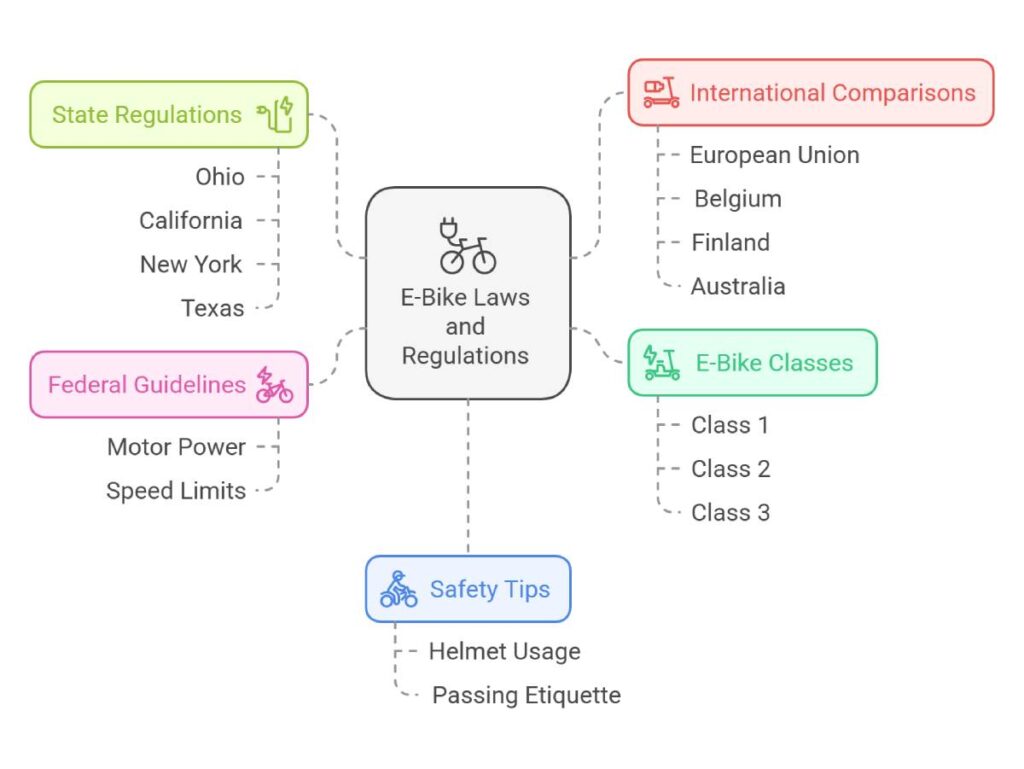In a world where electric bikes are zipping onto every street corner, understanding the labyrinth of e-bike laws is essential for every rider, seller, and manufacturer.
Imagine navigating a maze where each state has its own set of rules—confusing, right? Whether you’re cruising through California’s bike paths or speeding down Texas highways, staying streetwise with the latest regulations can keep your ride safe and legal.
Dive into our comprehensive guide that deciphers the complexities of electric bike laws, ensuring your journey is smooth, informed, and exhilarating. Let’s crack the code together and pedal confidently into the future of urban mobility.
Understanding E-Bike Regulations
E-bike rules in the U.S. are kinda like snowflakes—no two are the same. It’s a real mixed bag, so if you’re zooming around on one, selling ’em, or making these bad boys, it’s smart to know the rules to stay outta trouble and keep it safe on the streets.
State-Level Quirks
Each state likes to do its own thing with e-bike laws, making it feel like a road trip through a maze. They’ve got the power to be stricter or more chill than what Uncle Sam says. So, what’s okay in one state might get you a no-no in another.
More than 30 states have taken e-bikes and slapped some rules on ’em, usually throwing them into three classes, like sorting bikes into their own school cliques:
- Class 1 E-Bikes: These guys only help out when you pedal. No throttles here, buddy, and they max out at 20 mph.
- Class 2 E-Bikes: These come with a throttle to give you a gentle push up to 20 mph.
- Class 3 E-Bikes: Pedal power only, but they let you hustle at speeds up to 28 mph.
And if helmets, ages, or bike lanes make you scratch your head, don’t worry—each state has its own spin on them. For the nitty-gritty, check out these state-specific deets:
- Ohio regulations
- California regulations
- New York regulations
- Texas regulations
| State | Helmet Status | Age Advice | Max Miles Per Hour (Class 3) |
|---|---|---|---|
| Ohio | Yes, under 18 | 16 | 28 mph |
| California | Yeah, under 18 | 16 | 28 mph |
| New York | Under 18, you betcha | No limit | 28 mph |
| Texas | Your call | No limit | 28 mph |
Federal Advice: The Basics
The Consumer Product Safety Commission (CPSC) lays down some ground rules for e-bikes here in the U.S.A. They say that these electric wonders shouldn’t pack more than 750 watts of power. Plus, each one needs a class label slapping it. Here’s the quick lowdown:
- Speed Rules: E-bikes gotta keep within their specific class speeds.
- Helmet Wisdom: Helmets are smart, and sometimes, they’re even a must—state choice!
- Motor Might: No motors over 750 watts, okay?
- Label It: Every e-bike has to show its class on a label, like a little bike ID.
These rules give a base to work from, but everyone’s got their own spin on it. Best to keep an eye on local rules so you’re always in the know. Need more federal info? Check out these links:
Getting familiar with both the state and the federal e-bike playbook means you stay in the clear and hit the road with peace of mind. For more info on how the rules stack up, wander over to our full ebike standards guide.

Classifying E-Bikes
Sorting through electric bike rules can feel like solving a puzzle, but knowing the different categories of e-bikes is your first step to riding freedom. Basically, e-bikes in the United States fall into three main groups: Class 1, Class 2, and Class 3, each carrying its own set of rules that affect where you can cruise around on them (as noted by Really Good Ebikes).
Class 1 E-Bikes
Class 1 e-bikes are like having a friend pushing you while you pedal. The motor kicks in only as you pedal, and it helps you reach speeds of up to 20 mph. Most places welcome Class 1 e-bikes on bike paths and trails, making them perfect for people commuting to work or just enjoying a chill ride through the park.
| Feature | Specification |
|---|---|
| Assistance Type | Pedal-Assist Only |
| Maximum Speed | 20 mph |
| Motor Power | Up to 750W |
Class 1 is your go-to if you need a little help when going uphill or want to extend your ride without a throttle doing all the work. Hungry for tips on keeping your e-bike in top shape? Check out our article on electric bike maintenance.
Class 2 E-Bikes
Class 2 e-bikes come with a throttle, meaning you can ride without even touching the pedals. The throttle can get you up to 20 mph like Class 1. It’s a sweet deal for those who need a break from pedaling or have some physical challenges getting in the way.
| Feature | Specification |
|---|---|
| Assistance Type | Throttle-Assist |
| Maximum Speed | 20 mph |
| Motor Power | Up to 750W |
Class 2 e-bikes are great for delivery folks or older folks who want to keep moving. If you’re curious about the advantages for older riders, hop over to our guide on electric bikes for seniors to learn more.
Class 3 E-Bikes
For those who like a fast lane, Class 3 e-bikes offer pedal-assist up to 28 mph. They’re your best bet for quicker commutes and high-speed adventures. However, some spots may not allow Class 3 e-bikes, so make sure you’re up to speed on local rules before hitting the road.
| Feature | Specification |
|---|---|
| Assistance Type | Pedal-Assist |
| Maximum Speed | 28 mph |
| Motor Power | Up to 750W |
Class 3 usually has extra safety gear built-in, making them an appealing choice for speed fans. For more insights into motor types and how they play into riding experience, check out our guide on ebike motor types.
Grasping these classes can help you pick the right e-bike for your lifestyle while keeping in line with local laws. For more scoop on how these classes line up with state rules, swing by our Key Regulations by State section.
Key Regulations by State
Ever thought about cruising down the street on an electric bike? Before you hit the pedal, let’s break down what’s what in the e-bike arena across some states. Here’s the scoop you need!
Ohio Regulations
In Ohio, they’ve got a simple game plan for classifying bikes – you’ve got Class 1, Class 2, and Class 3. The main differences? How fast and how you ride.
| Type | Description | Path Usage | Helmet Requirement | Age Restriction |
|---|---|---|---|---|
| Class 1 | Pedal-assist only, max speed 20 mph | Enjoy those bike paths | No need | Everybody’s welcome |
| Class 2 | Throttle-assist, max speed 20 mph | Plenty of bike paths to explore | Nope | Come one, come all |
| Class 3 | Pedal-assist only, max speed 28 mph | No bike paths for these ones | Definitely | 16+ is the ticket |
Make sure your bike has pedals you can actually use, and don’t go over 750 watts with the motor—those are the house rules. Local folks might toss in extra rules, so maybe ask around before zooming off.
California Regulations
California’s e-bike scene is as meticulous as you’d expect. Like Ohio, it’s all about the classes:
| Type | Description | Path Usage | Helmet Requirement | Age Restriction |
|---|---|---|---|---|
| Class 1 | Pedal-assist, max speed 20 mph | Mostly path-friendly | Not if you’re under 18 | All ages |
| Class 2 | Throttle-assist, max speed 20 mph | Path friendly too | Skip the helmet if under 18 | Suitable for everyone |
| Class 3 | Pedal-assist, max speed 28 mph | Keep off Class 1 paths | Helmet on, no excuses | 16 and up only |
For Class 3, don’t forget a speedometer. And seriously, keep that helmet on no matter your age, cause rules.
New York Regulations
New York mixes federal vibes with a sprinkle of its own charm:
| Type | Description | Path Usage | Helmet Requirement | Age Restriction |
|---|---|---|---|---|
| Class 1 | Pedal-assist, max speed 20 mph | Bike path okay | Under 18 need it | No age bar |
| Class 2 | Throttle-assist, max speed 20 mph | You’re good on bike paths | Under 18 need it | Open to all ages |
| Class 3 | Pedal-assist, max speed 28 mph | Paths are off-limits | A must-wear | Begin at 16 |
Front and rear lights are a must-have on all electric bikes here. And for those Class 3 riders, helmets are part of the get-up, age no matter.
Texas Regulations
Down in Texas, they play it easy on e-bike rules:
| Type | Description | Path Usage | Helmet Requirement | Age Restriction |
|---|---|---|---|---|
| Class 1 | Pedal-assist, max speed 20 mph | Free to roam | Skip it | No restrictions |
| Class 2 | Throttle-assist, max speed 20 mph | Swinging free on paths | Why bother? | Everyone’s welcome |
| Class 3 | Pedal-assist, max speed 28 mph | Check those bike lanes | Nah | No limits here |
Helmets? They ain’t on the checklist. But going faster with Class 3? A helmet might just be smart for the noggin.
Curious about the e-bike world and want to keep rolling without hiccups? Scope our guides on electric bike battery care, how to charge an ebike, or get nerdy with electric bike maintenance. Looking to grab a bargain on a new ride? See our take on the best cheap electric bikes. Enjoy your ride!
Safety Considerations
Being a law-abiding e-bike rider isn’t just about staying out of trouble, it’s about keeping you and others safe. In this section, we’ll chat about helmets and how to pass safely, so you can pedal around with peace of mind.
Helmet Laws
Helmet rules can be a bit of a head-scratcher since they change depending on where you’re riding and what type of e-bike you have. But here’s the scoop: Slapping on a helmet is always a smart move, even if you technically don’t have to. Those things do wonders in reducing head injuries if you happen to take a spill.
- General Helmet Regulations: Some places think everyone should be wearing a helmet. Take Connecticut and Maryland, for example. They don’t care how old you are; if you’re on an e-bike, a helmet’s non-negotiable.
- Age-Specific Helmet Mandates: Other states focus on the kiddos. In California, anyone under 18 better be sporting a lid.
- Helmet Laws by E-Bike Class: Here’s where it gets interesting. Some states crack down harder on helmets if you’re riding a speed demon, like those Class 3 e-bikes that can hit 28 mph. More speed, more helmet rules.
Check out this handy table summing up some state laws:
| State | Helmet Law | Age Requirement | Class-Specific Law |
|---|---|---|---|
| California | Mandatory for riders under 18 | Under 18 | Yes |
| Connecticut | Mandatory for all riders | All ages | No |
| Maryland | Mandatory for all riders | All ages | No |
| New York | Mandatory for riders under 14; recommended for all riders | Under 14 | Yes |
| Texas | Varies by city; some cities require helmets for riders under 18 | Under 18 (city-specific) | No |
For the nitty-gritty details on your neck of the woods, swing by our page on electric bike security.
Passing Laws Awareness
Knowing how to pass safely is just smart biking. It’s all about not crowding or freaking out other folks on the road—pedestrians, other cyclists, and regular cars included.
1. Basic Passing Etiquette:
- Always overtake on the left.
- Leave plenty of room so you’re not spooking the socks off anyone.
- When you’re in the city, resist that urge to pass cars on the right—drivers can’t see you as well, and that’s a recipe for trouble.
2. Special E-bike Passing Rules:
- Yep, some states have extra rules about how e-bikes can pass. Sometimes that means stickin’ to designated paths, especially if you’re on a higher-speed e-bike.
- Make double sure you know the local passing laws based on your specific ride.
Being a courteous road warrior makes everyone a happy camper. For more tips on riding like a pro, check out our electric bike safety features page.
In areas where people congregate like lemmings, it’s good to play nice and follow passing laws. It’ll keep things smooth on your ride and less of a saga for everyone else.
Stick to these advice nuggets to stay safe and savvy. If your e-bike needs some love, our electric bike maintenance page has got you covered.
Motor and Speed Specifications
Grasping the ins and outs of motor power and speed for e-bikes ain’t just bureaucratic mumbo jumbo; it’s key to cruising safely and staying on the right side of the law. Let’s dig into the nitty-gritty of both federal and state rules that govern these vital aspects of electric bike laws.
Motor Power Limits
E-bike motor power isn’t just a techy number; it tells you what kind of slow or zooming ride you’ve got. The feds have their rules, but states? Well, they’ve got a little wiggle room to make their own.
| Class | Motor Power Limit (W) |
|---|---|
| Class 1 | 750W |
| Class 2 | 750W |
| Class 3 | 750W |
Every e-bike class has its power governed by Uncle Sam to ensure they’re easy to handle and won’t turn your commute into a rocket race. To geek out more about the motor types, hop over to our piece on ebike motor types.
Speed Limits per Class
E-bike speed can change—depending on the class, it tells you where you can roll and whether you need to gear up with extra protection like a helmet.
| Class | Max Speed Limit (mph) | Required Helmet | Riding Paths |
|---|---|---|---|
| Class 1 | 20 | Varies by State | Standard Bike Paths |
| Class 2 | 20 | Varies by State | Standard Bike Paths |
| Class 3 | 28 | Yep, Required | Designated Roads Only |
Class 3 e-bikes, zooming up to 28 mph, have tighter rules. Usually, you’ve gotta be 16 or older and rock a helmet. They aren’t typically allowed on your usual bike paths but stick to designated roads. Want the full scoop? Check out our section on ebike safety features.
E-bikes roll into three main categories:
- Class 1: Pedal-Assist only, tops out at 20 mph
- Class 2: Throttle-Assist, also 20 mph cap
- Class 3: Pedal-Assist, but faster, usually hitting 28 mph
It’s crucial to know that rules can switch up based on where you’re at. To keep it legit and safe, make sure to stay tuned into these updates. For more on where each e-bike type slots, hit up ebike classifications.
Always double-check your local and state rules to dodge any fines or mishaps. The federal stuff lays the groundwork, but places like California and New York may toss in some curveballs.
Knowing your e-bike’s muscle and speed limits ain’t just about checking boxes; it amps up your ride to be safer and more fun. Dive into our detailed look at electric bike power ratings if you’re hungry for technical tidbits.
Licensing and Registration
Trying to make sense of all the e-bike rules can feel like deciphering grandma’s favorite recipe, but it’s necessary to keep the law on your side and ride safely. Regulations swing from state to state, reflecting local ideas about bikes mingling with traffic. This part will dive into the nitty-gritty of licensing and registration requirements for e-bikes across the U.S.
State-Specific Licensing
Each state sets its own rules for electric bike licenses, and it’s as scattered as your kid’s toys. Age limits, helmet laws, and the occasional road smarts test are part of the mix. These rules help make sure e-bikers zoom around safely rather than resembling a scene from a slapstick comedy.
| State | Licensing Requirement | Minimum Age | Helmet Requirement |
|---|---|---|---|
| California | No special license needed | 16 | Under 18? Strap on that helmet |
| New York | No special license needed | 16 | Everyone needs helmet hair |
| Ohio | No special license needed | 16 | Under 18? Your head needs a hat |
| Texas | No special license needed | None | No. Nada. Zilch. |
Sourced from Really Good Ebikes
Registration Requirements
Does your bike need registration? Maybe. It depends. Registration serves to ensure who owns what and keeps things tidy on a state level. Here’s a look at what’s required by the state:
| State | Registration Required | Comments |
|---|---|---|
| California | Nope | Applies to fancy Class 1, 2, and 3 e-bikes |
| New York | Nope | Applies to Class 1 and 2 e-bikes |
| Ohio | Sometimes | City rules apply; double-check your local area |
| Texas | Nope | None of the e-bike classes bother with this |
Sourced from Really Good Ebikes
Getting the hang of e-bike rules in your neck of the woods keeps you riding without fearing a ticket. Stay on the straight and narrow by checking out links for more about e-bike types at ebike classifications or lock down your ride at electric bike security.
E-Bike Regulations Internationally
European Union Regulations
So you’re curious about how the EU handles e-bikes, huh? Well, over there, electric bicycles get sorted out according to the EU Directive 2002/24/EC. If your e-bike has a motor pushing out a maximum of 250W and doesn’t zoom past 25 km/h, it’s just a regular ol’ bicycle. The cool bit? You don’t have to deal with licensing, registration, or insurance. Here’s a quick breakdown:
| Category | Motor Output | Max Speed | License Needed | Insurance Needed |
|---|---|---|---|---|
| Pedelecs | ≤250W | 25 km/h | Nope | Nope |
| S-Pedelecs | >250W | >25 km/h | Yep | Yep |
Need more deets on e-bike styles? Go ahead and peek at our ebike standards comparison.
Belgium and Finland Laws
Belgium
Belgium keeps things simple with three e-bike classes. Got a Category A e-bike? You’re in luck! With speeds capping at 25 km/h, there’s no need for a helmet, insurance, or registration paperwork. Here’s the scoop:
| Category | Max Speed | License Needed | Insurance | Helmet Needed |
|---|---|---|---|---|
| A | 25 km/h | Nope | Nope | Nope |
| B | 45 km/h | Yep | Yep | Yep |
Finland
Finland doesn’t mess around; it plays by stricter rules. E-bikes kicking out 250W to 1,000W need to be registered and insured, setting Finland a bit apart from its EU buddies.
Australia’s Approach
Down under in Australia, they like their e-bikes simple. If it runs between 200W and 250W, put those license and registration concerns aside. Still, there’s a big focus on keeping things safe with clear speed rules and age limitations. Here’s how it lines up:
| Category | Motor Output | Max Speed | License Needed | Registration Needed |
|---|---|---|---|---|
| Standard E-Bike | 200-250W | 25 km/h | Nope | Nope |
For peeps wanting to dive deeper, check out our tips on electric bike battery care and discover our picks for the best folding electric bikes.
If you’re thinking of taking your e-bike globetrotting, knowing the rules across borders can save you a headache. Be sure to keep your ride smooth with our guide on electric bike maintenance.
Guiding Principles for Riders
Age Restrictions
You gotta know the age game with e-bikes ’cause it ain’t the same everywhere! States make their own rules, and the rules change with the e-bike class you’re dealing with. Take Ohio, for example. They’re pretty chill with Class 1 and Class 2 e-bikes—anyone can hop on. But for those speedy Class 3 types, you need to be at least 16 to ride. Got a buddy under 16? They’re cool as passengers if the bike’s got a buddy seat.
| E-Bike Class | Age Limbo Dance (Ohio) |
|---|---|
| Class 1 | No limits, ride free |
| Class 2 | No limits, ride free |
| Class 3 | 16+ go-getters only |
Wanna get deeper into the age talk? Swing by our article on ebike age considerations.
Riding Path Designations
Now, where you roll your wheels is another story. E-bikes and their adventures through paths and trails come with their own set of rules, especially in cities where things can get tricky. In Ohio, it’s a pretty clear road map: Class 1 and Class 2 e-bikes can glide down bike and shared-use paths. Class 3? Gotta stick to the roads—no shortcuts through those paths for you. Also, the local big cheeses might toss you some extra curveballs with special path rules.
| E-Bike Class | Smooth Path Moves (Ohio) |
|---|---|
| Class 1 | Bike and shared paths are home |
| Class 2 | Bike and shared paths are home |
| Class 3 | Stick to roads, buddy |
Always a good plan to chat with local folks about which roads are open to e-bikes. If you’re all about knowing your path, vibe with our guide on ebike commuting paths.
Getting the hang of age rules and road designations makes e-biking a smoother ride. Wanna dive into more e-bike rules and nifty tips? Check out our related reads on electric bike laws and ebike safety features.
Conclusion
Navigating the intricate landscape of electric bike laws might seem daunting, but staying informed empowers you to ride confidently and safely. From understanding the classification system—Class 1, 2, and 3—and adhering to state-specific regulations, to embracing essential safety measures like helmet usage and proper passing etiquette, every aspect plays a pivotal role in your e-bike journey.
Moreover, recognizing international standards broadens your perspective, especially if you’re considering riding beyond U.S. borders.
Remember, the foundation set by federal guidelines ensures a baseline of safety and legality, but local nuances require your attention. Equip yourself with the knowledge from our comprehensive guide, and make informed decisions whether you’re commuting, leisurely cruising, or embarking on high-speed adventures.
Ultimately, being streetwise about e-bike laws not only keeps you out of trouble but also enhances your overall riding experience. Stay updated, ride responsibly, and enjoy the freedom that electric biking brings to your life.
FAQs
What are the different classes of e-bikes?
E-bikes are categorized into three classes:
- Class 1: Pedal-assist only, up to 20 mph.
- Class 2: Throttle-assist, up to 20 mph.
- Class 3: Pedal-assist, up to 28 mph.
Do I need a license to ride an e-bike in the U.S.?
Generally, no special license is required for Class 1 and Class 2 e-bikes. However, some states have specific requirements for Class 3 e-bikes, including age restrictions.
Are helmets mandatory for all e-bike riders?
Helmet laws vary by state and e-bike class. Some states require helmets for all riders, while others mandate them only for certain age groups or e-bike classes.
Can I ride my e-bike on bike paths?
It depends on the state and the e-bike class. Typically, Class 1 and Class 2 e-bikes are allowed on bike paths, whereas Class 3 may be restricted to roads.
What is the maximum motor power allowed for e-bikes in the U.S.?
Federal regulations limit e-bike motors to a maximum of 750 watts.
Do e-bike regulations differ internationally?
Yes, countries like those in the EU, Belgium, Finland, and Australia have their own distinct e-bike classifications and regulations.
Final Thoughts
Staying informed about electric bike laws is more than just a legal necessity—it’s a commitment to safety and responsible riding. As e-bikes continue to revolutionize urban transportation, understanding the rules of the road ensures that you can fully enjoy the benefits without unexpected hurdles.
Whether you’re a daily commuter, a weekend adventurer, or a business owner dealing in e-bikes, knowledge is your best gear.
Keep abreast of both federal and state regulations, respect safety protocols, and embrace the evolving landscape of e-biking. At MyBikeReview.com, we’re dedicated to providing you with the latest insights and comprehensive guides to empower your e-bike journey.
Ride smart, stay safe, and let your electric bike adventures thrive!
Key Tips
- Know Your E-Bike Class: Familiarize yourself with Class 1, 2, and 3 e-bikes to understand where you can ride and what regulations apply.
- Always Wear a Helmet: Regardless of legal requirements, wearing a helmet enhances your safety.
- Stay Updated on Local Laws: E-bike regulations can change; regularly check state and local laws to remain compliant.
- Maintain Your E-Bike: Regular maintenance ensures your e-bike operates safely and efficiently.
- Respect Pedestrians and Other Cyclists: Practice courteous riding to make shared spaces enjoyable for everyone.
Recommended Biking Products and Accessories
- Helmet: Giro Aether MIPS Helmet – Superior protection with advanced safety features.
- E-Bike Lock: ABUS Granit X-Plus 540 U-Lock – High-security lock to protect your e-bike.
- Bike Lights: Lumos Smart Helmet – Integrated lights for enhanced visibility.
- E-Bike Maintenance Kit: Park Tool E-Bike Repair Kit – Essential tools for keeping your e-bike in top shape.
- Bike Computer: Garmin Edge 830 – Advanced tracking and navigation for your rides.
- Safety Gear: Bright Eyes Reflective Vest – High-visibility gear for safer nighttime riding.
- Motor Upgrades: Bafang E-Bike Motors – Reliable motor upgrades for enhanced performance.
- Battery Packs: Bosch PowerPack – Long-lasting batteries for extended rides.
- E-Bike Throttle Kits: Swytch Throttle Kit – Easy-to-install throttle kits for versatile riding options.
- Bike Racks: Thule Bike Carrier – Sturdy carriers for transporting your e-bike safely.
These products enhance safety, performance, and the overall e-bike experience, aligning with the key topics discussed in the article.




